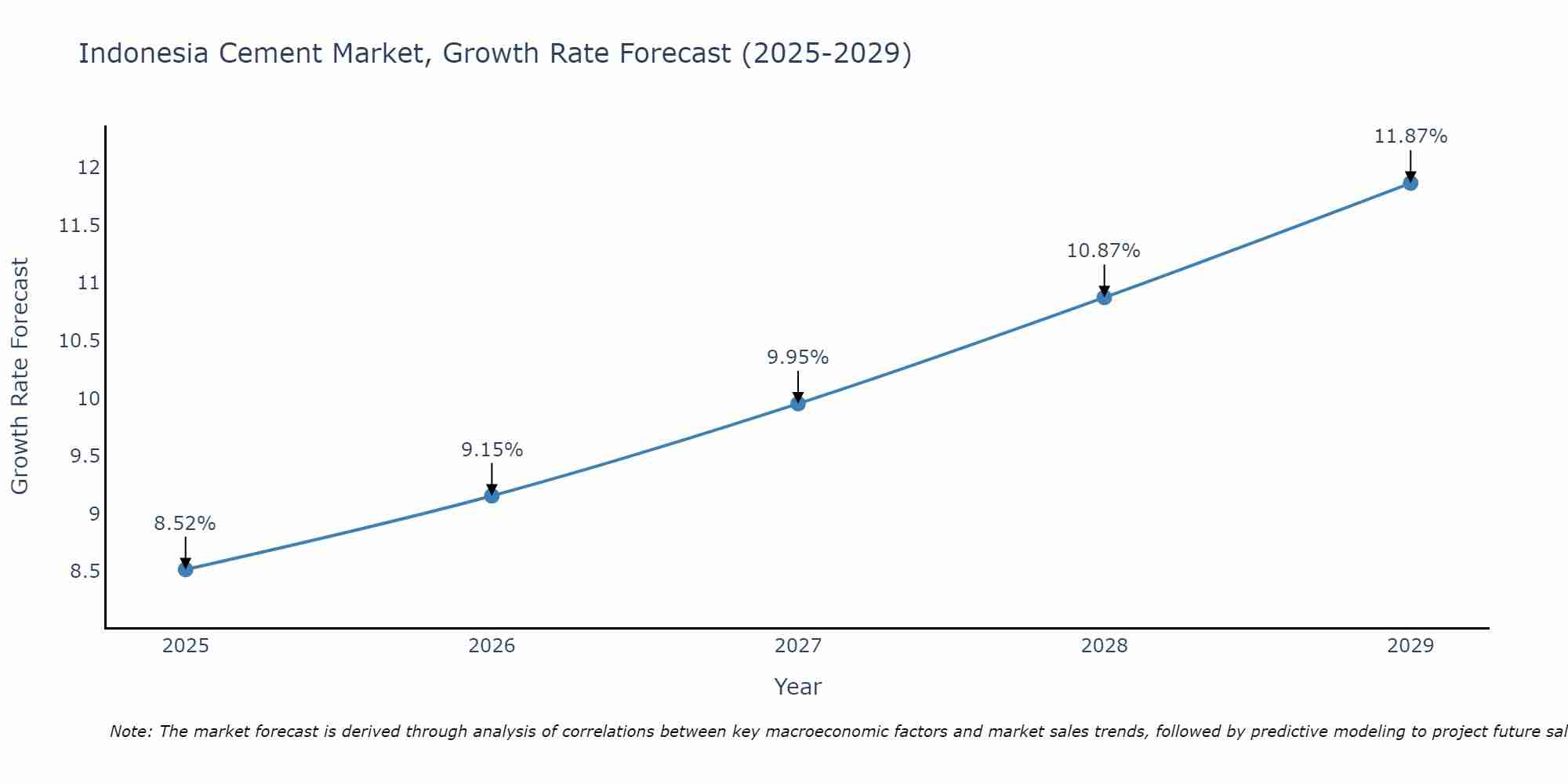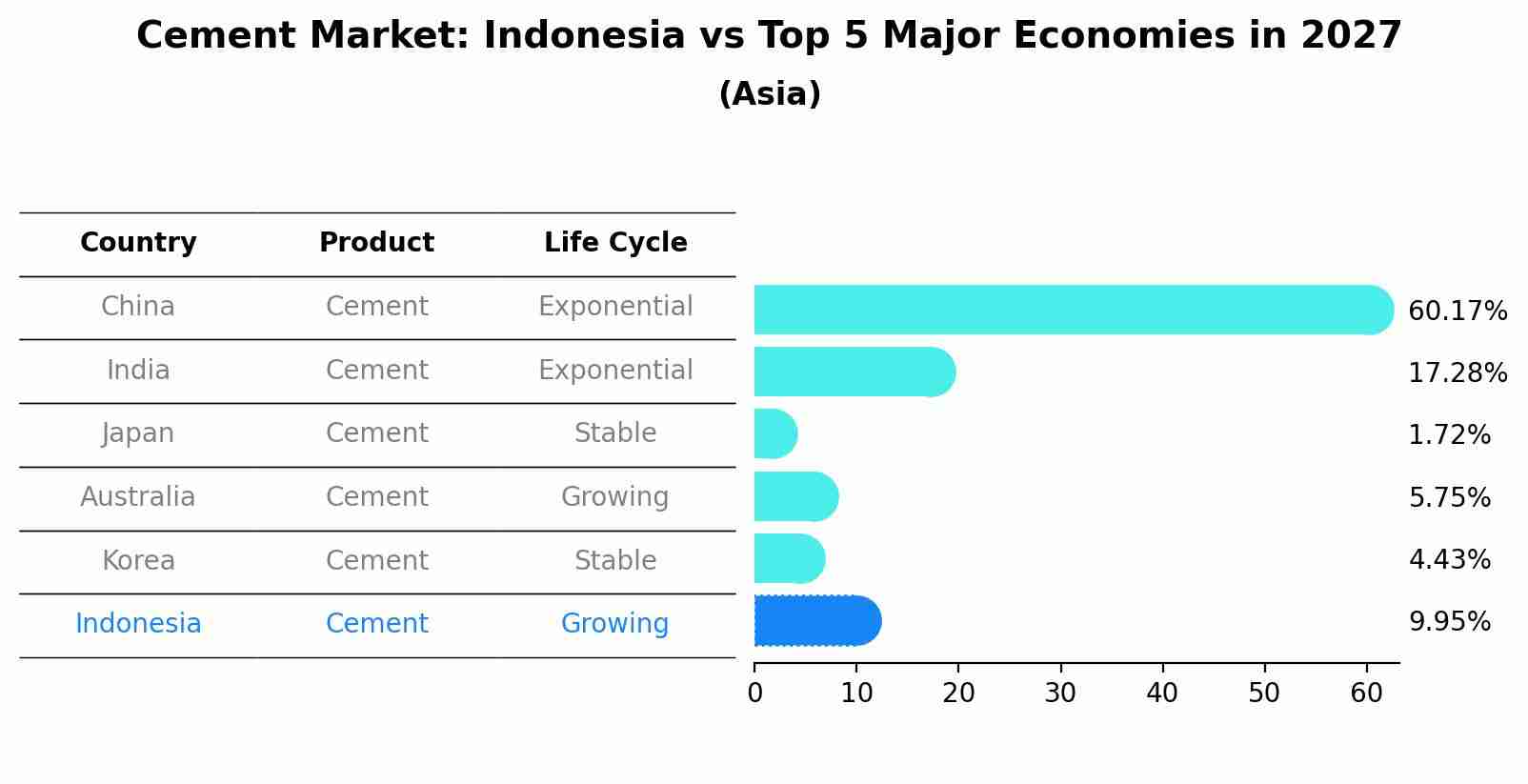Indonesia Cement Market (2024-2030) | Industry, Trends, Forecast, Outlook, Analysis, Companies, Value, Share, Size, Growth & Revenue
| Product Code: ETC023268 | Publication Date: Jul 2023 | Updated Date: Apr 2025 | Product Type: Report | |
| Publisher: 6Wresearch | No. of Pages: 70 | No. of Figures: 35 | No. of Tables: 5 | |
Indonesia Cement Market Size Growth Rate
The Indonesia Cement Market is poised for steady growth rate improvements from 2025 to 2029. Commencing at 8.52% in 2025, growth builds up to 11.87% by 2029.

Cement Market: Indonesia vs Top 5 Major Economies in 2027 (Asia)
The Cement market in Indonesia is projected to grow at a growing growth rate of 9.95% by 2027, highlighting the country's increasing focus on advanced technologies within the Asia region, where China holds the dominant position, followed closely by India, Japan, Australia and South Korea, shaping overall regional demand.

Indonesia Cement Market Synopsis
The Indonesia cement market was d at USD 9.4 billion in 2020 and is expected to reach aof USD 12.6 billion by 2026 registering a CAGR of 5.7% during theperiod (2021-2026). The increasing need for infrastructure development and urbanization are some of the major drivers for theof Indonesia`s cement . Additionally growing investment from both domestic and foreign entities has led to an increase in construction activities across the country further driving demand for cement over theperiod.
Key Factors Driving the Marke
1. Increasing Infrastructure Development: In recent years there have been several initiatives undertaken by the government that focus on improving social infrastructure such as roads bridges railways airports and ports among other projects which require substantial investments from private entities along with active participation from public sectors such as state-owned enterprises or ministries/agencies involved in each project thus driving demand for cement in Indonesia construction sector over time. 2. Growing Investment: There has been a surge in direct foreign investments into Indonesia`s economy through various channels including joint venture arrangements between localand multinational corporations as well as sole proprietorship businesses set up exclusively by non-Indonesia investors leading to increased activity within its constructionresulting in higher consumption levels of cement within this space since 2019 until present day helping drive demand for it within the country?s regional markets going forward too.
Challenges Facing the Market
1) High Prices due to Limited Supply Sources ? The limited availability of raw materials needed to produce high quality cements can push prices upwards making it difficult for domestic manufacturers competing against imports while negatively impacting consumer purchasing power when buying these products. 2) Environmental Regulations Restrictions ? Stringent environmental regulations imposed on production processes related to cements manufacturing may hinder profitability margins while also limiting overall output capacities throughout different regions where these restrictions apply adversely affecting supply chain dynamics regionally. 3) Competition From Low Cost Imports? Intense competition faced from low cost imported goods flooding certain segments/niches often leads local producers having difficulty maintaining their marketwhich can result them facing pricing pressures especially when operating within highly competitive environments like those found Indonesia industrial landscape today requiring careful strategic planning ahead every step taken accordingly otherwise failure awaits any business seeking success here without taking such precautions beforehand.
Key Highlights of the Report:
- Indonesia Cement Market Outlook
- Market Size of Indonesia Cement Market, 2023
- Forecast of Indonesia Cement Market, 2030
- Historical Data and Forecast of Indonesia Cement Revenues & Volume for the Period 2020-2030
- Indonesia Cement Market Trend Evolution
- Indonesia Cement Market Drivers and Challenges
- Indonesia Cement Price Trends
- Indonesia Cement Porter's Five Forces
- Indonesia Cement Industry Life Cycle
- Historical Data and Forecast of Indonesia Cement Market Revenues & Volume By Product for the Period 2020-2030
- Historical Data and Forecast of Indonesia Cement Market Revenues & Volume By Portland for the Period 2020-2030
- Historical Data and Forecast of Indonesia Cement Market Revenues & Volume By Others for the Period 2020-2030
- Historical Data and Forecast of Indonesia Cement Market Revenues & Volume By Application for the Period 2020-2030
- Historical Data and Forecast of Indonesia Cement Market Revenues & Volume By Residential for the Period 2020-2030
- Historical Data and Forecast of Indonesia Cement Market Revenues & Volume By Non-residential/Infrastructure for the Period 2020-2030
- Indonesia Cement Import Export Trade Statistics
- Market Opportunity Assessment By Product
- Market Opportunity Assessment By Application
- Indonesia Cement Top Companies Market Share
- Indonesia Cement Competitive Benchmarking By Technical and Operational Parameters
- Indonesia Cement Company Profiles
- Indonesia Cement Key Strategic Recommendations
Frequently Asked Questions About the Market Study (FAQs):
1 Executive Summary |
2 Introduction |
2.1 Key Highlights of the Report |
2.2 Report Description |
2.3 Market Scope & Segmentation |
2.4 Research Methodology |
2.5 Assumptions |
3 Indonesia Cement Market Overview |
3.1 Indonesia Country Macro Economic Indicators |
3.2 Indonesia Cement Market Revenues & Volume, 2020 & 2030F |
3.3 Indonesia Cement Market - Industry Life Cycle |
3.4 Indonesia Cement Market - Porter's Five Forces |
3.5 Indonesia Cement Market Revenues & Volume Share, By Product , 2020 & 2030F |
3.6 Indonesia Cement Market Revenues & Volume Share, By Application , 2020 & 2030F |
4 Indonesia Cement Market Dynamics |
4.1 Impact Analysis |
4.2 Market Drivers |
4.3 Market Restraints |
5 Indonesia Cement Market Trends |
6 Indonesia Cement Market, By Types |
6.1 Indonesia Cement Market, By Product |
6.1.1 Overview and Analysis |
6.1.2 Indonesia Cement Market Revenues & Volume, By Product , 2020-2030F |
6.1.3 Indonesia Cement Market Revenues & Volume, By Portland, 2020-2030F |
6.1.4 Indonesia Cement Market Revenues & Volume, By Others, 2020-2030F |
6.2 Indonesia Cement Market, By Application |
6.2.1 Overview and Analysis |
6.2.2 Indonesia Cement Market Revenues & Volume, By Residential, 2020-2030F |
6.2.3 Indonesia Cement Market Revenues & Volume, By Non-residential/Infrastructure, 2020-2030F |
7 Indonesia Cement Market Import-Export Trade Statistics |
7.1 Indonesia Cement Market Export to Major Countries |
7.2 Indonesia Cement Market Imports from Major Countries |
8 Indonesia Cement Market Key Performance Indicators |
9 Indonesia Cement Market - Opportunity Assessment |
9.1 Indonesia Cement Market Opportunity Assessment, By Product , 2020 & 2030F |
9.2 Indonesia Cement Market Opportunity Assessment, By Application , 2020 & 2030F |
10 Indonesia Cement Market - Competitive Landscape |
10.1 Indonesia Cement Market Revenue Share, By Companies, 2023 |
10.2 Indonesia Cement Market Competitive Benchmarking, By Operating and Technical Parameters |
11 Company Profiles |
12 Recommendations |
13 Disclaimer |
- Single User License$ 1,995
- Department License$ 2,400
- Site License$ 3,120
- Global License$ 3,795
Search
Related Reports
- Portugal Electronic Document Management Market (2025-2031) | Strategy, Consumer Insights, Analysis, Investment Trends, Opportunities, Growth, Size, Share, Industry, Revenue, Segments, Value, Segmentation, Supply, Forecast, Restraints, Outlook, Competition, Drivers, Trends, Demand, Pricing Analysis, Competitive, Strategic Insights, Companies, Challenges
- France Electronic Document Management Market (2025-2031) | Strategy, Consumer Insights, Analysis, Investment Trends, Opportunities, Growth, Size, Share, Industry, Revenue, Segments, Value, Segmentation, Supply, Forecast, Restraints, Outlook, Competition, Drivers, Trends, Demand, Pricing Analysis, Competitive, Strategic Insights, Companies, Challenges
- Portugal Occupational Health & Safety Services Market (2025-2031) | Strategy, Consumer Insights, Analysis, Investment Trends, Opportunities, Growth, Size, Share, Industry, Revenue, Segments, Value, Segmentation, Supply, Forecast, Restraints, Outlook, Competition, Drivers, Trends, Demand, Pricing Analysis, Competitive, Strategic Insights, Companies, Challenges
- Netherlands Occupational Health and Safety Services Market (2025-2031) | Strategy, Consumer Insights, Analysis, Investment Trends, Opportunities, Growth, Size, Share, Industry, Revenue, Segments, Value, Segmentation, Supply, Forecast, Restraints, Outlook, Competition, Drivers, Trends, Demand, Pricing Analysis, Competitive, Strategic Insights, Companies, Challenges
- Belgium and Luxembourg Facility Management Market (2025-2031) | Strategy, Consumer Insights, Analysis, Investment Trends, Opportunities, Growth, Size, Share, Industry, Revenue, Segments, Value, Segmentation, Supply, Forecast, Restraints, Outlook, Competition, Drivers, Trends, Demand, Pricing Analysis, Competitive, Strategic Insights, Companies, Challenges
- Russia Women Intimate Apparel Market (2025-2031) | Strategy, Consumer Insights, Analysis, Investment Trends, Opportunities, Growth, Size, Share, Industry, Revenue, Segments, Value, Segmentation, Supply, Forecast, Restraints, Outlook, Competition, Drivers, Trends, Demand, Pricing Analysis, Competitive, Strategic Insights, Companies, Challenges
- Africa Chocolate Market (2025-2031) | Size, Share, Trends, Growth, Revenue, Analysis, Forecast, industry & Outlook
- Global Hydroxychloroquine And Chloroquine Market (2025-2031) | Industry, Trends, Size, Outlook, Growth, Value, Companies, Revenue, Analysis, Share, Forecast
- Saudi Arabia Plant Maintenance Market (2025-2031) | Industry, Size, Growth, Revenue, Value, Companies, Forecast, Analysis, Share & Trends
- Taiwan Electric Truck Market (2025-2031) | Outlook, Industry, Revenue, Size, Forecast, Growth, Analysis, Share, Companies, Value & Trends
Industry Events and Analyst Meet
Our Clients
Whitepaper
- Middle East & Africa Commercial Security Market Click here to view more.
- Middle East & Africa Fire Safety Systems & Equipment Market Click here to view more.
- GCC Drone Market Click here to view more.
- Middle East Lighting Fixture Market Click here to view more.
- GCC Physical & Perimeter Security Market Click here to view more.
6WResearch In News
- Doha a strategic location for EV manufacturing hub: IPA Qatar
- Demand for luxury TVs surging in the GCC, says Samsung
- Empowering Growth: The Thriving Journey of Bangladesh’s Cable Industry
- Demand for luxury TVs surging in the GCC, says Samsung
- Video call with a traditional healer? Once unthinkable, it’s now common in South Africa
- Intelligent Buildings To Smooth GCC’s Path To Net Zero













